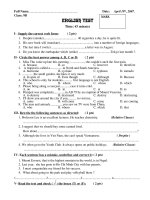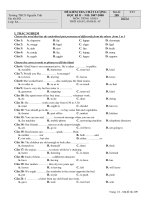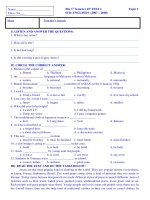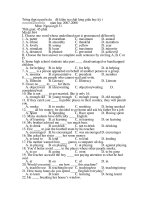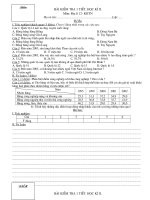week 1 slides s06 2 accounting
Bạn đang xem bản rút gọn của tài liệu. Xem và tải ngay bản đầy đủ của tài liệu tại đây (874.58 KB, 50 trang )
Accounting
Prof: Jim Wallace
TA: Charles Yeh
Overview of Week 1
Administrative stuff
What is financial accounting?
Financial statements
GAAP
What number do you want?
Administrative Stuff
Who am I
Who is your T.A.
Teaching philosophy
Syllabus
Homework
Calculator
Web Access to Class Info
The site should contain:
Syllabus
PowerPoint slides
Handouts
Homework solutions
/>
What is Financial Accounting?
A method to communicate financial information to
interested external parties.
Users include capital providers, regulators,
customers, suppliers, employees, etc
Capital suppliers include debt and equity providers
Financial accounting is used for both prediction
and control
Some Preconceptions
- Misconceptions?
Accounting yields the “truth.”
Accounting is rigid.
Accounting is useless.
Accounting is hard!
Accountants are boring.
Other Types of Accounting
Managerial
Non-profit
Tax
The Financial Statements
The accounting equation
Balance Sheet
Income Statement
Statement of Cash Flows
Statement of Owners Equity
Statement of retained earnings
Balance Sheet
Mirrors the Accounting Equation
Assets = Liabilities + Equity
Uses of funds = Sources of funds
Assets are listed in order of liquidity
Current and non-current
Liabilities are listed in order of maturity
Equity consists of Contributed Capital and
Retained Earnings
Assets
To be reported on a balance sheet, an
asset must:
1.
2.
Be owned or controlled by the
company
Must possess expected future
benefits
Most Assets are Reported at
Historical Cost
Historical Cost is
Objective
Verifiable
Therefore, not subject to bias
However, historical cost is not particularly
“relevant” to most readers of the balance sheet
“Relevance vs. Reliability” is an important issue
with accountants.
Disney’s Assets
Liabilities
Liabilities are listed in order of maturity
Current Liabilities come due in less than a year.
Noncurrent liabilities come due after a year.
Companies desire more current assets than current
liabilities – this difference is called net working
capital
Disney’s Liabilities and Equity
Equity
Equity consists of:
Contributed Capital (cash raised from the issuance of shares)
Earned Capital (retained earnings). Retained Earnings is updated each period as follows:
Market Value vs. Book Value
Stockholders’ equity = Company book value
Book value is determined using GAAP.
Book value is not the same as Market Value.
Market Value = # of Shares x Price per share
On average, US company book value is roughly
two-thirds of market value.
Income Statement
Walt Disney’s Income Statement
Accrual Accounting
Accrual accounting refers to the
recognition of revenue when earned
(even if not received in cash) and
the matching of expenses when
incurred (even if not paid in cash).
Accrual Accounting
Accrual accounting rests on two guiding
principles:
Revenue Recognition Principle – record revenue
when
Earned
Realized or Realizable
Matching Principle – record expenses when
Incurred
Neither the recognition of revenue nor the
recording of expense necessarily involves the
receipt or payment of cash
Statement of Stockholders’ Equity
Statement of Equity is a reconciliation of the
beginning and ending balances of stockholders’
equity accounts.
Main equity categories are:
Contributed capital
Retained earnings (including Other Comprehensive Income or OCI)
Treasury stock
Disney’s Statement of Stockholders’
Equity
Statement of Cash Flows
Statement of cash flows (SCF) reports cash
inflows and outflows
Cash flows are reported based on the three
business activities of a company:
1.
2.
3.
Operating activities: transactions related to the
operations of the business.
Investing activities: acquisitions and divestitures of
long-term assets
Financing activities: issuances and payments toward
equity, borrowings, and long-term liabilities.
Walt Disney
Company’s
Statement of
Cash Flows
Articulation of Financial Statements
Financial statements are linked within and across
time – they articulate.
Balance sheet and income statement are linked via
retained earnings.
Absent of equity transactions such as stock
issuances and purchases and dividend payments,
the change in stockholders’ equity equals the
income or loss for the period.


